
Mesdames de France
Encyclopedia





Louis XV of France
Louis XV was a Bourbon monarch who ruled as King of France and of Navarre from 1 September 1715 until his death. He succeeded his great-grandfather at the age of five, his first cousin Philippe II, Duke of Orléans, served as Regent of the kingdom until Louis's majority in 1723...
, most of whom lived at the royal court and never married.
Filles de France
Unlike other unmarried daughters of the nobility who were born demoiselles, the princesses who were the daughters of the kings of France were born with the rank and title of "dame."A Daughter of France (fille de France) was thus addressed as Madame, followed by her first name or her title if she had one. The treatment was the same with the sole exception that with the eldest, it was not necessary to add the first name, and the simple appellation "Madame" sufficed to designate her.
The sister-in-law of the king was similarly treated. When one existed (this was the case for Louis XIV of France
Louis XIV of France
Louis XIV , known as Louis the Great or the Sun King , was a Bourbon monarch who ruled as King of France and Navarre. His reign, from 1643 to his death in 1715, began at the age of four and lasted seventy-two years, three months, and eighteen days...
and Louis XVI of France
Louis XVI of France
Louis XVI was a Bourbon monarch who ruled as King of France and Navarre until 1791, and then as King of the French from 1791 to 1792, before being executed in 1793....
but not for Louis XV, who was the sole surviving sibling), the first of the filles de France was given the title of "Madame Royale."
A particular group
The appellation of "Mesdames" remained in history because of particular genealogical, political, and strategic circumstances that caused many of the eight daughters that Louis XV had with Marie Leszczynska to remain at the French court, including:- Marie Louise Élisabeth of FrancePrincess Louise Élisabeth of FranceLouise Élisabeth de France was the eldest daughter of King Louis XV of France and his Queen consort, Maria Leszczyńska, and the elder twin sister of Anne Henriette de France. As the daughter of the king, she was a Daughter of France...
(1727 - 1759), Madame - Henriette Anne de France (1727 - 1752), her twin, entitled Madame Seconde, then Madame after the marriage of her twin sister
- Marie Louise de FrancePrincess Louise of FranceMarie Louise de France, fille de France was a French Princess by birth. She was one of 10 children.-Biography:...
(1728 - 1733), Madame Troisième, then Madame Louise - Marie Adélaïde de France (1732 - 1800), Madame Quatrième, then Madame Troisième, then Madame Adélaïde and finally Madame, after the death of Madame Henriette
- Marie Louise Thérèse Victoire de France (1733 - 1799), Madame Quatrième, then Madame Victoire
- Sophie Philippine Élisabeth Justine de FrancePrincess Sophie-Philippine of FranceSophie Philippine Élisabeth Justine de France, fille de France was a French princesse du sang. She was the sixth daughter and eighth child of Louis XV of France and his Queen consort Marie Leszczyńska. First known as Madame Sixième, she later became Madame Sophie.-Biography:Sophie is less well...
(1734 - 1782), Madame Cinquième then Madame Sophie - Marie Thérèse Félicité de FrancePrincess Thérèse of FranceThérèse de France, fille de France was a French Princesse du Sang.-Biography:...
(1736 - 1744), Madame Sixième, then Madame Thérèse - Louise Marie de France (1737 - 1787), Madame Septième or Dernière, then Madame Louise
At Versailles
To economise on their maintenance at court, and to prevent the queen (to whom a large, allied brood would give comfort) from having too much influence, the last four of the princesses were raised far from the court, at Poitou in theFontevraud Abbey
Fontevraud Abbey
Fontevraud Abbey or Fontevrault Abbey is a religious building hosting a cultural centre since 1975, the Centre Culturel de l'Ouest, in the village of Fontevraud-l'Abbaye, near Chinon, in Anjou, France. It was founded by the itinerant reforming preacher Robert of Arbrissel, who had just created a...
from 1738 to 1750, where they passed their formative years before returning to Versailles. Madame Thérèse did not return to Versailles, and Madame Louise came back, but was very strongly influenced by the monastic life, to which she later returned at Carmel de Saint-Denis.
The king kept the eldest one at his side; he was attached to her and separation made him very sad. Madame Adélaïde owed her maintenance at Versailles to her wishes and her successful request to remain near the king, whom she knew how to influence.
Mesdames, together with the Dauphin, sustained a long battle against the successive mistresses of their father, particularly Madame de Pompadour
Madame de Pompadour
Jeanne Antoinette Poisson, Marquise de Pompadour, also known as Madame de Pompadour was a member of the French court, and was the official chief mistress of Louis XV from 1745 to her death.-Biography:...
, who they called amongst themselves "Maman putain" (Mama Whore). Their support of the cause of the devout was permanent, and the reason, for their entire tenure at court, for their difficult relation with the king, who only consented very late to let them occupy apartments on the ground floor of the main building at Versailles
Versailles
Versailles , a city renowned for its château, the Palace of Versailles, was the de facto capital of the kingdom of France for over a century, from 1682 to 1789. It is now a wealthy suburb of Paris and remains an important administrative and judicial centre...
, the apartments which today bear their name.
Among them, Madame Adélaïde was the one that exercised the most political role at the court, managing her sisters after the death of Madame Henriette in 1752, and intriguing unceasingly in favor of her brother and for the reestablishment of moral order at court.
Upon the accession to the throne of her nephew, she cherished the hope of exercising an influence over him but was soon forced to realize that he would not give her the role she wished. Pushed away from power bit by bit, and representing the old court against the new generation, she increasingly retired with her sisters to the Château de Bellevue
Château de Bellevue
The Château de Bellevue was a small château built for Madame de Pompadour in 1750. It was constructed on a broad plateau in Meudon, above a slope overlooking the Seine to the east, but was demolished in 1823 and little remains....
, which had been constructed for Madame de Pompadour. They finally obtained it and passed most of the last decade of the ancien régime there.
After the days of October 1789, Adélaïde and Victoire retired to Bellevue, from whence they fled, ending up, after much wandering, in Italy, where they spent the remainder of their days.

